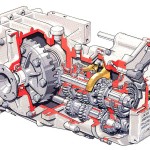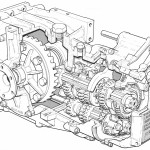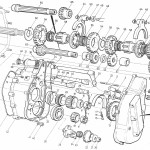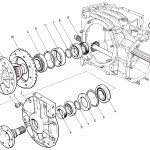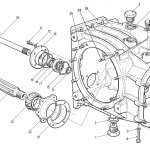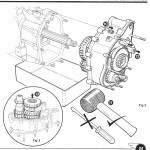Interview: Andrew Kitson

There are people involved in racing that have talent beyond belief. Andrew Kitson is one. He is an illustrator and painter…
By Andrew Kitson
A few details. I was trained as a technical illustrator and spent a bit of time in the ’80s and ’90s working in the German car industry, whilst simultaneously starting to do my racing paintings on my time off. Eventually the painting took over!
As a freelance illustator, during a couple of trips home early in 1988, I took on a project in conjunction with a company called Ensign Publications in Huntingdon, to produce the maintenance manual for the new Hewland LD200 box, which was initially designed for the new Formula Forward. The boss of Ensign publications, himself an ex-bike racer, oversaw the project and was also the technical author, I did the illustrations.
Mark Bailey, now a Club F3 team owner, was the designer at Hewland at the time. I worked closely with him, using his blueprint technical drawings for reference…no computers in those days! We also had a mock up gearbox casing to work from. This cut-away drawing was done in pencil first on tracing paper, approximately 30 inches wide if I recall correctly.

One of the skills of a technical illustrator is the ability to choose a view that would show all relevant parts and assemblies clearly and, where necessary, draw the cut in the casing to show these, yet still give the outline shape of the actual gearbox and casing. Once the pencil drawing was checked by Mark, the pen and ink stage was done using Rotring illustration pens onto transparent draughting film, tracing the pencil lines. Finally a sharp full size black & white print was produced and I added the colour to the actual print using pantone colour.
All of these practices, very much done by hand, are sadly being lost now, due to the advancement in computer graphics software.
Back then, we had to look at the pile of ‘flat’ technical drawing blueprints, work out how it was assembled and visualise what it would look like in a ‘3D’ view and produce the illustration to show it. This was often the first view the designer would see of their creation in this way. But nowadays with CAD, the designers can turn their object on the screen, whatever it is they are designing, look at it from whatever angle they wish and print it out, even render and colour it. It was our job back then to show them how a prototype or concept would look using pencils and pens.
Special thanks to Andrew Kitson, not only for the image but the description of how it was done.
Illustrations by Andrew Kitson ©Hewland Engineering 1988 www.andrewkitson.com
Follow @MotosportRetro and @Hallbean on Twitter and join in on the discussion on Facebook

